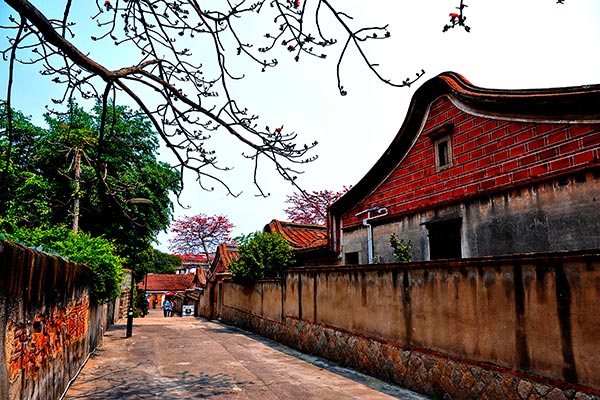.jpg)
With remarkable natural beauty and historical charms, Gulangyu Island in Xiamen, Fujian province is a shining example of ecological tourism.[Photo by Lin Congming/China Daily]
A popular tourist destination renowned as the “garden on the sea”, Gulangyu Island in Xiamen, Fujian province will compete with nine other Chinese cultural sites to be included on the UNESCO World Heritage list in 2016.
Covering an area of 1.88 square kilometers, the island is famous for its sandy beaches, winding lanes, and diverse architecture and culture. Gulangyu first applied to become a World Heritage site in 2008.
It has to clear three hurdles before finally being recognized by the United Nations Educational, Scientific and Cultural Organization.
In November 2012, it was listed on the preparatory directory for World Cultural Heritage sites in China.
There are more than 40 sites in China on the tentative UNESCO list. Ten of them-including Gulangyu, the Liangzhu Archaeological site in Zhejiang province and the Huashan Rock Paintings in the Guangxi Zhuang autonomous region-are seeking to become the next representative from China.
With a mixture of Western and traditional Chinese culture, the island of Gulangyu is unique, with well-crafted gardens, winding alleyways, pristine beaches, distinctive shops and diverse architectural styles. The high number of pianos adds to the charm of the small island.
In 2005, it was named one of the most beautiful districts in China by the Chinese language National Geography Magazine.
In the early days, Gulangyu was only a small fishing village.
Its distinctive development began in 1909 when it became an international settlement for foreigners.
Different from international communities in Shanghai, Dalian and Qingdao, the island was an official international settlement jointly managed by more than 10 countries.
Western culture brought by foreigners soon combined with traditional Chinese ways of life.

Haitan road in Gulangyu attracts visitors from home and abroad.[Photo by Lin Congming/China Daily]
Popular spot
Only a short ferry ride from urban Xiamen, the province’s dynamic economic and culture hub, Gulangyu is home to some 20,000 residents.
The island’s full line of supplies for daily life, the tranquil environment, and well-managed traffic and municipal systems, have attracted resident celebrities including China’s first Doctor of Music Chen Zuohuang, famed writer and translator Lin Yutang, and the noted woman poet Shu Ting.
In 1985, President Xi Jinping, then vice-mayor of Xiamen, said in a report that Gulangyu is one of the few places that well blends the natural view with the cultural landscape.
“Its national treasure needs unified planning and comprehensive protection,” said Xi.
Early this year, a “community garden” program began on the island with deserted gardens and unused land cultivated with flowers and plants by community volunteers. The idea came from a self-governing international community in Montreal, Canada.
Ye Chonggeng, head of the Xiamen Publicity Department, said Gulangyu aims to attract more international experts and become World Cultural Heritage Site.
“Gulangyu has its own uniqueness, it’s not simply a place of interest, but also residents’ community. It needs balanced development,” Ye said.
“It is our hope that every tourist that visits the island can understands the distinct and valuable cultural elements on Gulangyu Island,” he said.
Isle of pianos
Gulangyu Island in Xiamen, Fujian province has a history dating back more than 1,000 years.
In more recent times it was a trading port in the 1840s and an official international settlement in the early 1900s.
Western architecture and artists then developed along with the traditions of southern Fujian.
More than 2,000 intact historical buildings make the island one of the best-preserved international settlements in the country.
The villa once owned by Lin Henian, a poet in the Qing Dynasty (1644-1911), is a fine example of classical Chinese style, while the Ru’nan Villa was built in 1935 in European style.
The buildings also tell the stories of history. They include the former residences of famed figures such as Xu Chuncao, an important member of Chinese Revolution Party in the early 1900s, and music prodigy Xu Feiping, who won a series of international piano concerto competitions in the 1980s.
And music is a vital part of Gulangyu’s culture. Known as an island of pianos and music, a large proportion of families in the local community have special ties with music.
Piano and organ museums on the island host important music festivals and contests regularly.
Other musicians born on the island who gained high recognition include pianist and composer Ying Chengzong and Chen Zuohuang, China’s first doctor of music.
Ye Chonggeng, head of Xiamen Publicity Department, said it was important to learn cultural protection and management from the experiences of eastern European countries that have joined the ranks of World Heritage sites.
The city should try to use private funds to renovate historical buildings and ease the government’s financial pressure, he noted.
The government could also make full use of private resources to improve management and add cultural elements in the development of tourism.
Ye plans to set up a team of professionals to protect Gulangyu in the long-term and draw up rules and regulations to improve the management of the island’s buildings and environment.
